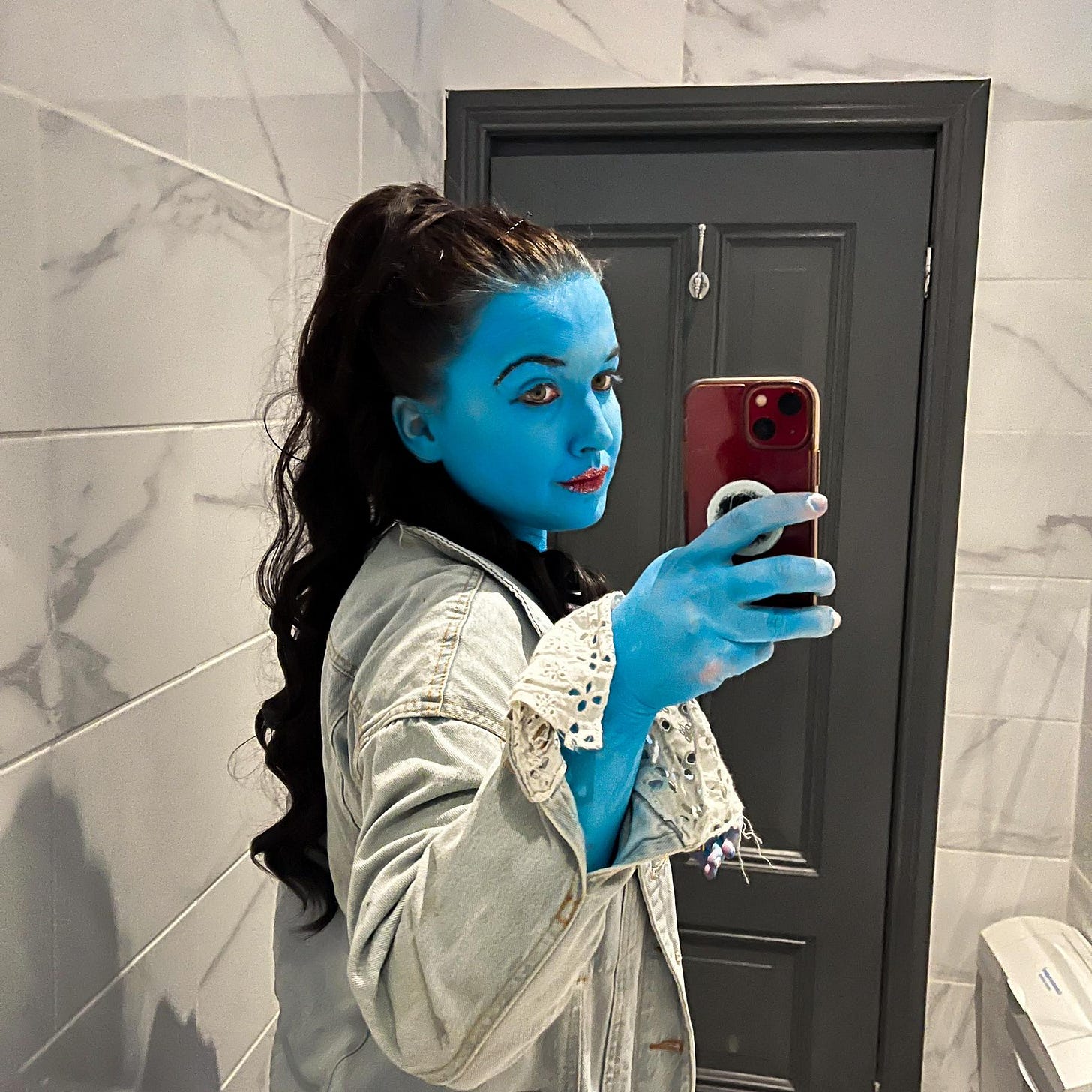🎭 The Panto Diaries | The Perfect Panto Recipe
All the ingredients the audience expects in their freshly served panto cake.
If there’s one thing I’ve learned over the past five years, it’s that there’s an algorithm to writing a pantomime. Now, because I know the world algorithm can be a bit scary, let’s just think of it as a recipe for baking the perfect panto cake - and hopefully none of you are scared of cake, right?!
Much like a good wedding, a pantomime always contains four key ingredients: something old, something new, something borrowed, and something blue. Yes. Something blue, just stay with me.
Without diving too deep into the exact measurements I use to bake the panto cakes, we’ll explore some of the specific ingredients today that have contributed to the success of previous scripts over the years.
It’s time to open the recipe book and turn to the first page…
⚠️The Disclaimer
Now’s probably as good a time as any to say that this ‘perfect’ panto recipe is perfect according to me. This is what I enjoy putting in my panto mixture. Probably also a good time to warn you that this is the same person who enjoys the strongest cordial known to mankind, coffee with five billion sugars in it, and ordered a Caramel (3 pumps) Frappucino from Starbucks recently with 3 extra pumps of vanilla. Did I nearly die? Maybe. Was it right after a one-hour-long dental appointment…? Just don’t tell my dentist.
OKAY! So now the level of unhinged you’re dealing with is established as a disclaimer, let’s get started on pulling apart the old, new, borrowed, and blue of the pantomime recipe.
☁️ Something old
One of the most brilliant things about panto is that it’s comfy. It’s a bit like your favourite winter jumper to bring a bit of comfort to the dreary, dark months the season brings. And, let’s face it, while we don’t get to hibernate, we do get a few good things over winter to make up for it. I’d argue the warm embrace of a good pantomime, filled with belly laughs, is one of them.
And that’s why us panto-goers go back year on year, isn’t it? We want to laugh, we want to be amused and, most importantly, we go expecting to see certain things - and those are the ones we often enjoy the most.
As humans, we just love that familiar, cosy feeling.
I’m going to give you a few ‘old’ things our audience loves to see each year, and are always featured in some way, shape, or form as a consequence;
The melodrama of the leading actors; the rom-com, the heart of the story, the leading lady and man. Traditionally, the role of the leading male would go to a woman and vice versa. In a lot of modern panto performances, that no longer seems to be the case, but what is still the case? The audience expects there to be a love story, and plenty of melodrama to boot. And no good love story is complete without a wedding to close out the show. A good panto rarely feels fully complete without a big, fancy wedding.
The Dame; we all know and love dames as part of a good panto tradition - and I think most would argue a panto isn’t complete without one! Whilst other comic characters exist, the panto dame always receives some of the loudest applauses, and is the one entrance the audience waits with bated breath to see. She’s always played by a man and is always in an over-the-top outfit. She’s also usually on the lookout for love, and often enters the audience to try and find a husband - or to insult members of the audience, and sometimes sit on their knee if they’re (un)lucky. Pro tip: avoid the aisle seats like the plague.
Audience interaction; whether you prefer hiding in the audience cringing at the thought of being picked on, or you’re in the front row heckling with the best of them, there’s one thing that’s certain. Panto is well-known for, and really wouldn’t be the same without, a very noisy audience, and a lot of back and forwards between audience and cast members (oh no it wouldn’t).
✨ Something new
So, how do you balance out the old and also keep things as fresh as bedsheets hung out to dry in the summer sun? Well… sometimes with difficulty. But mostly, for me? In a moment of extreme daydream, when my brain monkey is doing really fast laps around my skull, or just as I’m about to fall asleep at night something utterly bizarre comes to me - and I think ‘great! straight into my notes app.’
So what exactly constitutes as new? Well, in this day and age, probably nothing. But I’ll give you some examples of recent (no spoilers) things that have come out of my poor, hyperactive mind - and have also, for some reason, gone down brilliantly on stage.
The same character, year on year; I’ve questioned how new this might be, I’m sure I’m not the first to come up with it. But, after the success of one particular, comic character, I’ve reintroduced him with a slight twist on his name and who he is to the story each year. He now appears year after year and is played by the same actor - the audience loves him, and he still manages to bring something new each year too.
A sword fight to a Sci-Fi instrumental; Yes, you read that right. One year, we had a wonderful professional actor, clown, stilt-walker, and sword-fighter (amongst other things) come and choreograph an actual on-stage sword fight to music for two of our actors. Phenomenal and impressive? Very. Did they also smash it? Yes. More reminiscent of a dramatic show like a West End Musical? Perhaps, but it went down a storm and added something pretty different to the norm.
‘Random’ moments; and before you ask, no I’ve not regressed to the early 2000s circa the #ThatsSoRandom era, but I have found over the course of the shows that our audience just loves weird. Unhinged? Great. A ‘you had to be there, and even then it didn’t make any sense’ moment? Even better. An example from a previous show? The Queen, the Archbishop of Canterbury and the royal guard doing the can can as it, obviously, got faster and faster. Fab.
🤝Something borrowed
Like most great art, panto inspiration comes in many forms - and one of those forms is borrowing things from other productions. In fact, there are whole books of slapstick scenes and other such fun panto must-haves from over the years designed to be shared and used by scriptwriters and directors.
Here are two examples I’ve seen in many of the shows I’ve been to over the years that I’ve also borrowed, too.
A ‘12 days of’ scene; a rewrite of the well-known and loved ‘12 days of Christmas’, the 12 days ‘panto versions’ are a little less refined - see the image beneath the disclaimer above. They’re packed to the brim with mess, the speed increases incrementally as the song goes on (cue extra hilarity) and, no matter how many times I see this run during rehearsals, it always goes beautifully wrong on show nights - as it should.
The Slop Scene; is the one we all know and love. The curtains open on a stage, often covered with tarpaulin and dotted with items like buckets, and sponges, and with a cleaning, decorating, or a kitchen theme. What time is it? Slop scene time. Usually set to music, with a bit of comic dialogue, this scene sees the comic actors covering each other in a variety of mess such as flour, water, silly string, and cream. Unsurprisingly there’s a long ‘in-front-of-curtains’ scene that follows this to allow time for clean-up.

🧞 Something blue
On a serious note, if there ain’t lots of colour, it ain’t a panto. We want colourful backdrops, props, costumes, and makeup. The bigger, and the bolder, the better. It’s a feast for your eyes. Like a bizarre cartoon coming to life.
On an un-serious note? It’s me. I was blue. For a week. And then my bathroom was very blue, as was my bed. So I never want to see the colour blue again.
That’s it! That’s the roundup of how a panto is like a wedding but is also akin to baking a Victoria sponge cake. So perhaps it’s like a Victoria sponge… at a wedding? Who knows. If you have any thoughts on this, drop them below! If you’re wondering if I need mental help? Shhh.








